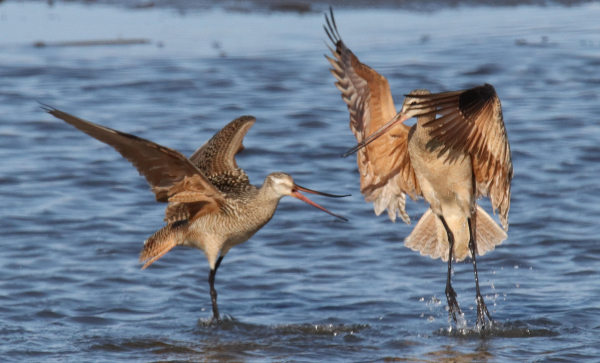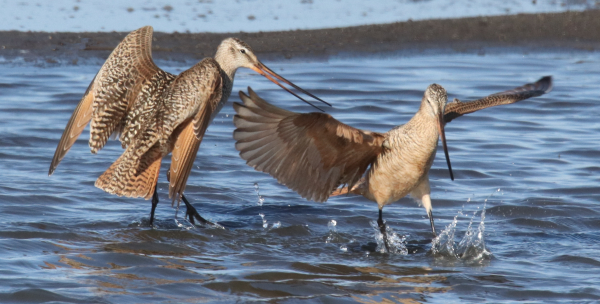We all appreciate any opportunities we get to be in a position to photograph birds, and while portraits and still photos are always highly appreciated, I am always watching for the next moment when the action begins. Being aware and anticipating action is important, as action among birds can be instant and veiled in a flurry of feathered excitement that may create unique photographs that can rarely be replicated. Sometimes the action is spontaneous, other times we have a moment to imagine a bird’s next move, like the direction of a takeoff or wingbeats after preening.

Other times the action may already be happening, and it’s up to us to focus on the bird or birds involved and follow on-going action with the hope of getting one photo or a series of quality photographs. A prime case in point might include a territorial interaction among birds that transpires when a new or neighboring bird enters another bird’s perceived territory or feeding area. Sometimes the concern is real, but in season, some birds seem to become overly aggressive. And that intense level of territorial behavior provided me with a couple extended action photo opportunities last spring that allowed me to take some unique action photos during extended chases and skirmishes that I witnessed while photographing a variety of shorebirds.

The birds involved are well-known for being a bit over-zealous in the early stages of the nesting season – American Avocets and Marbled Godwits. Coincidentally they were located in the same shallow marsh, the best shorebird feeding area of spring, which luckily enough is located only 2 miles north of home – Bobby’s Bay. With a seemingly ever-changing variety of sandpipers and plovers on hand, I could park my mobile blind (car) on the extended shoulder of the road on the east side of the marsh. That made it a prime photo location during late afternoon when the sun was lower in the western sky – perfect.
In the case of both species, the action was initiated by one hyper-aggressive bird. Usually territorial interactions like these are brief and they rarely come to blows, but the initiating birds were intense and their pursuits of the “trespassers” were long and continuing. I followed the action through my camera lens, and took photos when it seemed the birds were at the most interesting points in their interactions that lasted minutes rather than moments. That said, when you have a chance to photograph similar interactions between birds, take lots of photographs, because it’s very likely that only a few will actually be “keepers.”

Even so, the photos that do meet the grade can be somewhat spectacular, and I point at the first photo to illustrate this article as an example of an unexpected image that really shows action – not only from the birds, but from the accompanying water. The photographs published here can stand alone, or be included as part of a series – and in this case they are something of a mixed series to emphasize how exciting action photography can be – for the photographer in the moment, and in a presentation to others interested in birds and photographs of birds.

Technically, it’s important to be using the fastest shutter speed possible to stop motion, although any time there is blurred action in a photograph, it may have merit too, with the blur enhancing the action theme. As always, we contend with the balance between shutter speed to stop action at some level, and aperture to try to keep the birds in the area in focus, especially when there are 2 or more birds. For each of the photographs presented here, the fast shutter speeds stopped the sometimes frantic action and the f-8 to f-10 apertures were effective in keeping the birds in focus.

Realistically, the 5 action photographs show some extreme activity between the birds illustrated, but the same principles apply to any avian action you try to photograph to add drama or the beauty of motion in resulting images. In the end, the birds dictate our opportunities to photograph them (or not); and it’s up to us to be aware and to anticipate the potential of action, moment by moment. Taking action photos of birds is exciting, fun, rewarding, and likely to keep you on your toes the next time you are photographing. Bird photography, like the birds themselves, is unpredictable and that’s what makes it such a special part of birding. Enjoy your birding experiences with your camera and lens!
Article and Photographs by Paul Konrad
Share your bird photos and birding experiences at editorstbw2@gmail.com